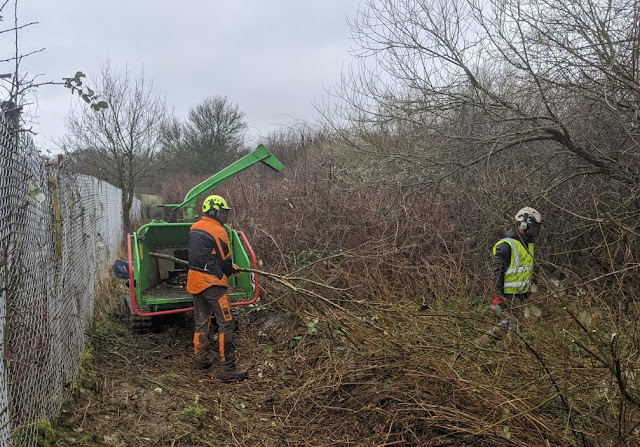Gatwick's Annual Biodiversity Review 2019 is now available to download from this link:
https://www.gatwickairport.com/globalassets/company/sustainability/reports/2019/biodiversity-annual-review-2019.pdf
The report includes lots of incredible species highlights and new initiatives in 2019, and we have had a huge number of contributors so I would like to thank single one of you. I’m looking forward to the 2020 field season and catching up with you all again!
Tuesday, 10 March 2020
Thursday, 5 March 2020
Gonna need an even bigger boat - Autumn and winter habitat conservation 2019/2020
Posted by
Rachel Bicker
Boardwalks continually being built by volunteers headed up by Gatwick Greenspace Project Officer Tom Simpson. These help to protect delicate woodland ground flora
Back when I was relatively new to the job, I wrote a post about how incredibly wet our sites were in February 2013; that was back when I hadn't known what to expect. Now seven winters later I do know, and it is abundantly clear from the state of our woodlands that this has been the wettest February on record.
Upper Picketts Wood is our lowest-lying woodland on site
It is a worry that our winters are getting observably wetter and warmer. Many organisms, such as plants and fungi need a consistently cold period during the life cycle to trigger certain developmental processes. Others need to hibernate, such as mammals like the Hazel Dormouse, all reptiles, and many invertebrates such as Brimstone butterflies, spiders and beetles. They need the cold in order to fully enter hibernation, and warm winters can badly interfere as they repeatedly wake up, sapping precious energy reserves which are supposed to last until spring.
Impacts on delicate woodland groundflora and microhabitats
Other impacts are immediately obvious, such as the widening of footpaths and increased poaching of soils due to people, dogs and even the deer avoiding the wettest parts. Tom Simpson's handy work installing boardwalks and 'slubbing out' woodland ditches is fortunately helping to alleviate this in the worst effected areas.
Sussex University students site visit; shoe aftermath
It is safe to say then that our contractors and conservation volunteers have really been up against it this winter. I've mostly been indoors writing up data for our annual review, nipping out only for short periods to carry out site checks. This intrepid lot have doggedly carried on, often for several rainy days in a row!
Gatwick Airport's I.T Team: re-lining the old Rolls Farm pond
Gatwick Greenspace Wildlife Rangers edging the pond with translocated native plants
(Photo by Tom Simpson)
A special thank you to all of our teams who have persevered through the relentless rain and bloody awful ground conditions. You do fantastic work and compared to seven years ago, many of our habitats have never been in such a good state.
Gatwick's Volunteer Reserve Managers - Harry, Phil, Robert and Chris
(Photo by Tom Simpson)
We now have the fantastic Volunteer Reserve Managers (VRMs), a team of veteran Gatwick Greenpsace Partnership volunteers who are well versed in the more sensitive habitat management tasks, often in difficult to access sites.
Photo by Tom Simpson
Chris and Phil (pictured above) have been busy in Goat Meadow, pushing back the scrub encroaching on the wildflower-rich grassland. Like the large herbivores which would have roamed freely around our sites long ago, they create patch disturbance, helping to maintain a dynamic system of constantly regenerating habitat.
Glendale Landscaping Services are the grounds maintenance contractors at the airport; they have had the unenviable tasks of clearing dense thorn scrub along neglected fencelines. This hard cutting and scalloping of scrub will open new areas along our survey transect routes, benefitting our sun-basking reptiles and invertebrates.
Myself, Glendale manager Jon Eglin and our bat surveyor Martyn Cooke have been dodging the rain showers to install bird nesting boxes around our woodlands, just in time for spring. These bespoke design boxes are to encourage rare and declining species we know to be breeding nearby.
Scrub west of Brockley Wood (Photo by Ben Lee)
Roots Upwards Ltd have continued the Blackthorn scrub management in the North West Zone, essential for regenerating growth for the rare Brown Hairstreak butterflies, while benefiting our wildflowers and pollinating insects. They have also been helping to move and replace our bat boxes using ropes and harnesses, collecting up reptile matts and shifting logs and habitat piles.
LERL Pond 3 chipping willows on the bank
Opening up an area on the southern edge of the pond to allow in more light (Photo by Ben Lee)
What a bunch of gosh-darn heroes you all are. Very muddy heroes. Now go in the garden, get under the hose, then you're allowed in the house.
Common Frog spawn at Land Eats Pond 3 (Photo by Ben Lee)
No complaints from the frogs and other amphibians though.
Subscribe to:
Comments
(
Atom
)















